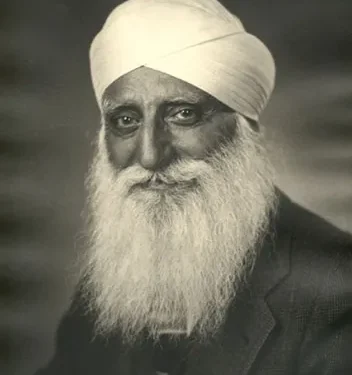Bhagat Singh Thind: The Vanguard of Immigration Law Reform
Introduction
Bhagat Singh Thind, a name that resonates with resilience, perseverance, and the pursuit of justice. Born on October 3, 1892, in Punjab, India, Thind’s life journey was far from ordinary.
He embarked on a quest for a better life, not just for himself but also for immigrants who would follow in his footsteps. Thind’s contributions to immigration law are immeasurable and continue to shape the landscape of equality and fairness in the United States.
A Trailblazer’s Journey
Hailing from a modest background in Punjab, India, Bhagat Singh Thind grew up amidst a society grappling with British colonial rule and its oppressive policies. Driven by an unwavering spirit and an unyielding passion for knowledge and justice, Thind sought an opportunity to escape the constraints of his homeland.
In 1913, he set sail across vast oceans to pursue higher education in America – the land of dreams. However, Thind soon realized that his journey didn’t end with crossing borders; it was just the beginning of another arduous chapter.
Like countless other immigrants at the time, he faced numerous challenges during his arrival and settlement process. The very nature of immigration laws placed formidable barriers before those seeking refuge or opportunities on American soil.
The Legacy that Transcends Time
Thind’s enduring legacy lies not only in his personal achievements but also in his profound impact on immigration law reform. His relentless pursuit of justice culminated in one landmark Supreme Court case that would forever change the course of U.S. naturalization laws: United States v. Bhagat Singh Thind (1923). The significance of this case cannot be overstated.
It challenged deeply rooted discriminatory beliefs held against non-white immigrants, specifically those of Indian descent. Thind’s case addressed the question of whether individuals from India, classified as Caucasians under a legal definition at the time, could be granted U.S. citizenship.
The Supreme Court’s ruling in favor of denying Thind’s citizenship highlighted the inherent racial biases ingrained within immigration law. Despite the outcome, Thind’s legacy continues to reverberate in the halls of justice and beyond.
His case exposed fundamental flaws in immigration policies that treated people differently based on their race or ethnicity. The echoes of his pursuit for equality inspired future generations to fight against discrimination and work towards creating a more inclusive and just society.
Early Life and Immigration Journey
A Multifaceted Upbringing in Punjab, India
Born in the lush region of Punjab, India, Bhagat Singh Thind’s early life was marked by a rich cultural tapestry. Growing up amidst the vibrant traditions of his homeland, Thind imbibed a deep sense of pride in his Punjabi heritage. His upbringing instilled values of sacrifice, courage, and intellectual curiosity that would shape his future endeavors.
Thind hailed from a close-knit family steeped in tradition. His parents were devout Sikhs who valued education and spirituality.
As a young boy, Thind immersed himself in religious texts and philosophical discourses under the guidance of wise elders. This formative upbringing not only nurtured his intellect but also impelled him to question societal norms and strive for equality.
The Siren Call of America: Motivations Behind Immigration
Amidst the allure of distant lands and new possibilities, Bhagat Singh Thind found himself drawn to the United States like a moth to flame. He yearned for freedom from colonial rule that plagued India at the time and sought refuge in the land that promised liberty to all who ventured there.
Thind’s decision to immigrate was driven by an insatiable hunger for knowledge and a burning desire to make an impact on an international stage. The United States presented itself as an intellectual haven—an arena where he could further his education, engage with diverse perspectives, and contribute meaningfully to society.
Navigating Choppy Waters: Challenges Faced during Immigration
Although driven by ambition and determination, Thind’s journey towards the American dream was rife with obstacles. Navigating bureaucratic hurdles proved arduous as he encountered stringent immigration laws designed to limit entry based on nationality or ethnicity. From securing travel documents to facing the scrutiny of immigration officials, Thind confronted a myriad of challenges.
Discrimination and racial bias complicated his path, forcing him to confront the harsh reality that opportunities in America were not equally available to all. Undeterred by these setbacks, he persevered, fueling his determination to fight against such unjust systems.
The journey from Punjab to the United States was one marked by both personal and societal transformation for Bhagat Singh Thind. The vibrant tapestry of his upbringing in Punjab laid the foundation for his intellectual curiosity and sense of identity.
Motivated by a thirst for knowledge and a yearning for freedom, he embarked on an arduous immigration journey that tested his resilience at every turn. Challenges encountered along the way sharpened his conviction to challenge discriminatory systems and left an indelible mark on his pursuit of justice in America’s immigration landscape.

The Naturalization Case of Bhagat Singh Thind
Pursuit of U.S. Citizenship through Naturalization
Imagine the year is 1920, and a determined Sikh immigrant named Bhagat Singh Thind sets foot on American soil with dreams of becoming a United States citizen. Thind, like many others who embarked on this journey, believed that attaining citizenship would not only grant him legal rights but also affirm his sense of belonging in his newfound home. With an unwavering determination, he began the process of naturalization – the legal means by which foreign-born individuals can become American citizens.
Examination of the Landmark Supreme Court Case: United States v. Bhagat Singh Thind (1923)
Thind’s quest for citizenship led to an extraordinary turning point in immigration law history – the landmark Supreme Court case known as United States v. Bhagat Singh Thind. This pivotal trial, which took place in 1923, examined whether individuals of South Asian descent were eligible for U.S. naturalization based on existing racial eligibility criteria.
Arguments Presented by Thind’s Legal Team
Thind’s legal team passionately argued that as an Asian Indian from Punjab, he should be considered “Caucasian” and therefore eligible for naturalization under the prevailing racial categories at that time. Their argument rested upon scientific theories popularized during that era regarding race and anthropological origins. The defense contended that since Punjabi people hailed from the Caucasus region in South Asia, they should be classified as “white.” The defense team argued that race should be defined based on anthropological criteria rather than mere physical appearance or complexion.
Supreme Court Ruling and Its Impact on Immigration Law
Despite compelling arguments put forth by Thind’s legal team, the Supreme Court ultimately delivered a crushing blow to his aspirations. The Court ruled that Thind, despite his Aryan ancestry and high moral character, did not meet the criteria for naturalization.
They concluded that even though Thind’s skin color might be light, he was not of the “white” race as intended by the framers of the Naturalization Act of 1790. This ruling had far-reaching consequences for immigration law.
It firmly established that individuals from South Asia, and by extension other non-white racial groups, were ineligible for U.S. citizenship under existing racial eligibility categories. This decision highlighted the deeply ingrained racial biases prevalent at that time and laid bare the discriminatory nature of immigration laws.
The Thind case illuminated the urgent need for reform in immigration policies and forced society to confront its preconceived notions about race and nationality. It served as a rallying cry for advocates seeking more equitable treatment of immigrants and paved the way for future challenges to discriminatory laws in pursuit of a more inclusive America.
Impact on Racial Eligibility for U.S Citizenship
Analyzing the Racial Eligibility Criteria for U.S Citizenship Before the Thind Case
Before delving into the impact of Bhagat Singh Thind’s case, it is essential to understand the racial eligibility criteria for U.S citizenship that existed prior to his landmark case. The Naturalization Act of 1790, enacted by Congress, stated that only “free white persons” could become naturalized citizens.
This narrow definition excluded individuals from various racial and ethnic backgrounds, including Asians and individuals of African descent. Over time, subsequent amendments were made to this Act, but they maintained the exclusionary focus on race.
For example, the Naturalization Act of 1870 expanded eligibility by allowing “aliens of African nativity” and “persons of African descent” to be naturalized. However, it still excluded individuals from other non-white racial groups.
The Aftermath of the Thind Case: Reevaluation of Racial Eligibility Criteria
The Supreme Court’s ruling in United States v. Bhagat Singh Thind (1923) had a significant impact on immigration law by challenging existing racial eligibility criteria for U.S citizenship. In this case, Thind argued that he should be eligible for naturalization as a “white person.” However, the Supreme Court ruled against him, stating that although he may be a high caste Indo-Aryan from India, he was not considered white under the common understanding at that time.
This ruling led to a reevaluation of racial eligibility criteria for U.S citizenship. While it did not immediately result in comprehensive changes to immigration laws or eliminate discrimination based on race entirely, it marked a pivotal moment in questioning discriminatory practices within immigration law.
Significance of the Ruling: Challenging Discriminatory Laws
The significance of the Thind case lies in its role as a catalyst for challenging discriminatory laws and initiating a broader conversation about racial equality in the United States. By questioning the exclusionary nature of racial eligibility criteria, Thind’s case shed light on the inherent flaws within immigration law and opened doors for future advocacy efforts. The ruling provided inspiration and precedent for subsequent cases that would challenge similar discriminatory practices.
Over time, it contributed to a more inclusive approach to immigration policy, gradually dismantling racial barriers in naturalization processes and paving the way for greater equality. Bhagat Singh Thind’s case had a profound impact on racial eligibility criteria for U.S citizenship.
It forced a reevaluation of existing laws, highlighting their discriminatory nature and prompting important discussions about equality under the law. While significant progress has been made since then, Thind’s legacy serves as a reminder of the ongoing struggle for justice and inclusion within immigration law.
Contributions to Immigration Law Reform
Thind’s Advocacy for Fair Immigration Policies
Bhagat Singh Thind’s impact on immigration law extends far beyond his landmark Supreme Court case. He was a passionate advocate for fair and equal treatment of immigrants, particularly those facing racial barriers in the naturalization process.
Thind recognized the inherent injustice of denying individuals the opportunity to become U.S. citizens solely based on their race or ethnicity. Thind tirelessly campaigned against discriminatory practices and actively voiced his concerns through various channels, such as public speeches and writings.
His eloquence and passion resonated with many, mobilizing support for reforms in immigration law. Thind’s advocacy efforts were crucial in bringing attention to the racial biases embedded within the system, ultimately pushing for change.
His Efforts towards Eliminating Racial Barriers in Naturalization Process
One of Bhagat Singh Thind’s most significant contributions to immigration law reform was his relentless pursuit of eliminating racial barriers in the naturalization process. Prior to his case, individuals of South Asian descent were often deemed ineligible for U.S. citizenship due to their non-European origins.
Thind challenged this discriminatory practice head-on, arguing that regardless of race or ethnicity, anyone who meets the other requirements should be granted equal consideration for citizenship. By highlighting his own extensive qualifications and service to the nation as a World War I veteran, Thind aimed to debunk any notion that race should play a role in determining one’s eligibility for citizenship.
Legislative Changes Influenced by Thind’s Case
The Supreme Court ruling in United States v. Bhagat Singh Thind directly influenced subsequent amendments to immigration laws, marking a turning point toward more inclusive policies. While the court ultimately denied Thind’s claim that he should be considered “white” under existing statutes, it recognized the need for a more comprehensive definition of racial eligibility for citizenship. Congress took note of this ruling and responded by introducing legislative changes.
The Cable Act of 1922, for example, allowed U.S. citizen women to retain their citizenship even if they married non-citizens. This amendment acknowledged the need to address gender-based discrimination in immigration law.
Furthermore, the Immigration and Nationality Act of 1952 represented a significant step towards reforming racial eligibility criteria. It replaced outdated terms like “free white persons” with broader categories such as “persons of good moral character,” providing a more inclusive framework for individuals seeking naturalization.
Thind’s case served as a catalyst for change, prompting lawmakers to reevaluate existing laws and create a more equitable immigration system. His dedication to justice continues to inspire future generations in their fight against discrimination and prejudice within immigration law.

Lasting Legacy and Influence
Impact on future cases involving race-based discrimination
Bhagat Singh Thind’s case had a profound impact on future cases involving race-based discrimination. The Supreme Court ruling in his case set a precedent that challenged the prevailing notion of racial eligibility for U.S. citizenship.
It paved the way for subsequent legal battles against discriminatory laws, inspiring activists and lawyers to fight for equal rights and justice. Thind’s case shed light on the need to reevaluate immigration laws that perpetuated racial inequalities, fueling the momentum for reform.
References to notable cases influenced by Thind’s precedent
Thind’s landmark case served as a reference point for numerous subsequent cases grappling with similar issues of race-based discrimination in immigration law. One such notable case is Oyama v. California (1948), where the Supreme Court cited Thind’s precedent to challenge discriminatory laws targeting Japanese immigrants seeking land ownership rights. Similarly, the influential civil rights case, Loving v. Virginia (1967), which struck down anti-miscegenation laws in the United States, drew inspiration from Thind’s fight against racial barriers in attaining citizenship.Bhagat Singh Thind’s unwavering determination and courageous battle against racial injustice continues to inspire individuals from diverse backgrounds today. His legacy serves as a reminder that one person can make a significant impact and bring about change even in seemingly insurmountable circumstances. His story encourages those who face adversity and discrimination to persistently challenge unfair laws and fight for equality.
Conclusion
Bhagat Singh Thind’s legacy in immigration law is an enduring testament to his indomitable spirit and commitment to justice. Through his landmark Supreme Court case, he challenged entrenched discriminatory practices and laid the foundation for future legal advancements. Thind’s influence extended beyond his own case, resonating in subsequent court battles and inspiring generations of activists.
His story reminds us that the pursuit of equality requires resilience, tenacity, and unwavering dedication. Though the journey towards justice may be arduous, Thind’s legacy inspires us to continue fighting for a more inclusive and equal society.











